If you’re on the hunt for the perfect cake donut recipe—crispy on the outside, moist and tender inside—you’ve landed in the right spot. Whether you’re a home baker looking to upgrade breakfast or someone craving a nostalgic bite of a diner-style donut, this guide walks you through the entire process.
From selecting the right ingredients and tools to step-by-step frying and glazing, we’re covering it all. Plus, we’ll tackle FAQs like: “Are cake donuts fried or baked?” and “Why are cake donuts so good?”
Table of Contents
Table of Contents
Looking for inspiration? Try Vegan Christmas Cookies Everyone Will Love if you want a dessert contrast! Now let’s get frying.
Introduction to the Perfect Cake Donut Recipe
What is a Cake Donut?
A cake donut is a type of donut that uses a chemical leavening agent (like baking powder or soda) instead of yeast. That means they don’t require rising time and are much quicker to make than their yeast-based cousins. They’ve got a rich, slightly dense crumb with a crisp outer layer—ideal for dipping into coffee or devouring fresh from the fryer.
Unlike yeast donuts, cake donuts hold their shape better, are easier for home cooks, and offer a flavor that’s buttery and satisfying. Their texture is similar to a muffin or cupcake but more compact and less crumbly.
History & Popularity of Cake Donuts in the USA
While donuts trace back to early Dutch settlers and beyond, cake donuts rose to fame during the 19th century in the U.S., particularly during World War I when rationing made yeast a scarce commodity. Their simplicity and speed made them popular among home cooks and bakeries alike.
Fast forward to today, and they remain an American staple. From local diners to gourmet bakeries, cake donuts are often the go-to choice for people looking for a rich, cakey, and deeply satisfying treat.
Don’t miss our Easy Sloppy Joe Recipe with Ketchup to pair with your sweet treat in a full comfort meal lineup.
Key Ingredients for the Best Cake Donuts
Understanding Each Ingredient’s Role
When it comes to making a successful cake donut recipe, each ingredient has a specific job that affects the texture, flavor, and structure. Let’s break it down:
- Unsalted Butter (4 oz): Adds richness and tenderness to the donut crumb while helping create that signature moist interior.
- Granulated Sugar (5 oz): Sweetens the dough and assists with caramelization during frying for a golden crust.
- Eggs (2 large): Eggs bind the ingredients together and add moisture, structure, and richness.
- Buttermilk (6 oz): This acidic liquid reacts with the baking soda to create a tender and fluffy texture. It also brings a tangy flavor that balances the sweetness.
- Vanilla Extract (2 tsp): Enhances the overall flavor profile and gives that warm, bakery-style aroma.
- All-Purpose Flour (15 oz): Provides the structural base. The key is not to overmix it, as this can toughen the donut.
- Baking Powder & Baking Soda: These are your leavening agents. They help the dough rise and create a light, cake-like texture.
- Nutmeg (½ tsp): The real MVP in this recipe. Nutmeg gives donuts that classic flavor you’ll recognize from your favorite bakery.
- Salt (½ tsp): Just a touch helps enhance and balance all the other flavors.
Check out How to Make Pancakes with Bisquick Better to see another example of how key ingredients transform simple recipes.
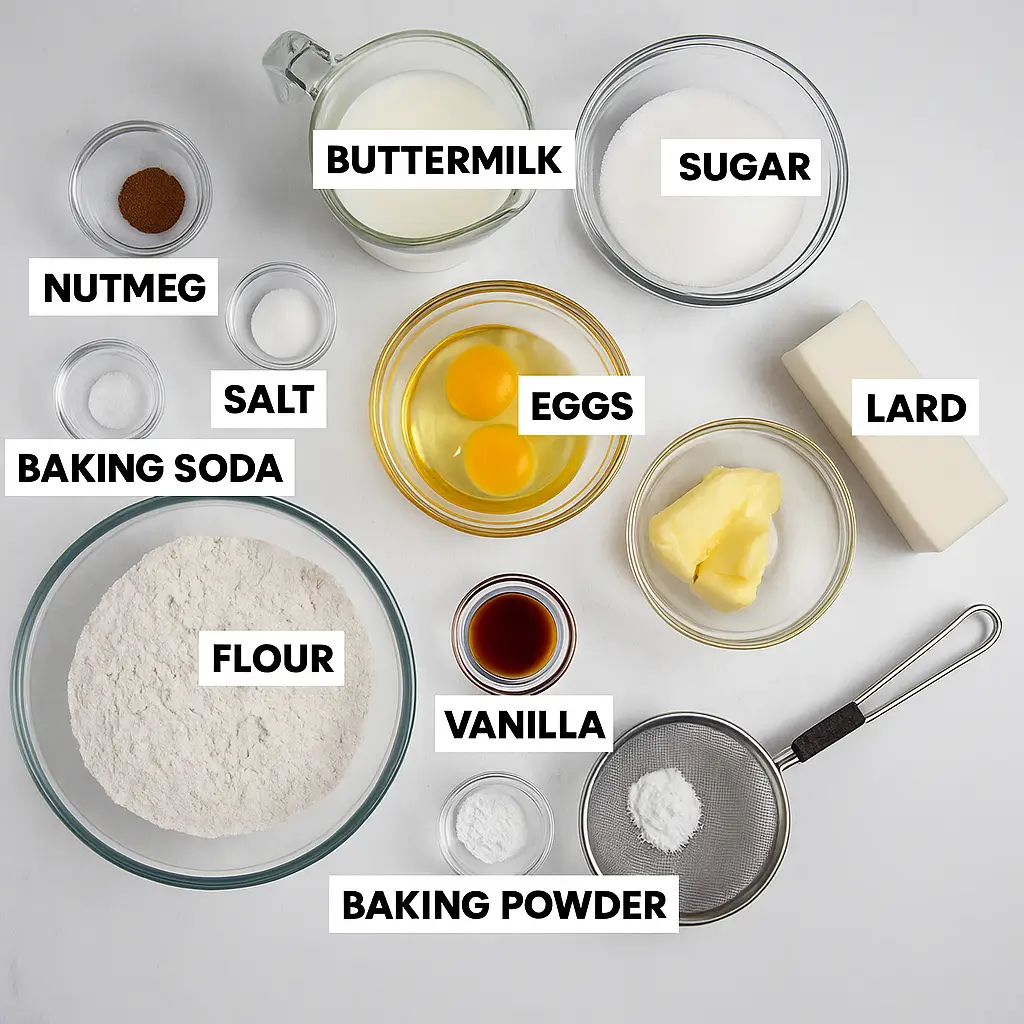
Why Buttermilk and Nutmeg Are Essential in a Cake Donut Recipe
Buttermilk isn’t just for fluffiness—its acidity works wonders on the proteins in the flour, resulting in a tender crumb. It also adds complexity to the flavor, making each bite more satisfying. Without it, your donuts can taste flat and lack that slightly tangy edge that contrasts the sweet glaze beautifully.
Nutmeg is what gives donuts their nostalgic taste. It’s subtle but instantly recognizable. Without it, your donuts might feel like basic cake circles rather than true old-fashioned delights. If there’s one spice you shouldn’t skip, it’s this.
Don’t miss our How to Make Slutty Brownies Step-by-Step at Home for more rich, flavorful baking ideas.
Equipment Needed for a Proper Fry
Must-Have Tools for Making Cake Donuts
To make the perfect cake donut recipe at home, the right tools are just as important as the ingredients. Here’s what you’ll need for flawless frying and shaping:
- Stand Mixer (with paddle or whisk attachment): Ensures even creaming of butter and sugar. You could use a hand mixer, but a stand mixer gives you more control and power.
- Rolling Pin: After the dough rests, a rolling pin helps flatten it evenly to your desired thickness, typically ½”.
- Donut Cutter or Biscuit Cutter Set: This shapes the classic donut and the donut hole. If you don’t have one, a wide-mouth glass and a bottle cap work in a pinch.
- Slotted Spoon or Spider Skimmer: Essential for lowering donuts gently into the oil and retrieving them without splashing.
- Cooling Rack and Sheet Pan: A wire rack over a pan helps oil drain off donuts evenly, preventing sogginess.
- Thermometer (Digital or Analog): Your oil must stay between 360°F to 375°F for ideal frying. A cheap kitchen thermometer will save you from undercooked or greasy donuts.
- Heavy Pot or FryDaddy Deep Fryer: A deep pot retains heat better and prevents overflow. A FryDaddy is ideal for consistent results if you’re frying often.
Choosing Between Fryer vs. Pot: Which Is Better for Frying?
Each has its pros and cons, and your choice depends on how often you plan to fry:
| Tool | Pros | Cons |
|---|---|---|
| FryDaddy | Maintains consistent oil temperature | Limited space; small batches only |
| Heavy Pot | Versatile and good for larger batches | Requires careful monitoring of temperature |
If you’re a donut enthusiast, the FryDaddy makes life easier. For casual use, a tall heavy-bottom pot and a thermometer will do just fine.
Discover great ideas like Sun-Dried Tomato and Feta Stuffed French Toast to serve as a savory brunch complement to your sweet donuts.
Step-by-Step Guide to Making the Dough
Creaming Butter and Sugar the Right Way
Let’s dive into the heart of your cake donut recipe—the dough. The first step sets the tone for the entire batch: creaming butter and sugar. Here’s how to do it right:
- Use room temperature butter. This allows it to mix evenly with sugar, creating a fluffy base.
- In your stand mixer, beat together 4 oz of softened unsalted butter and 5 oz of sugar on medium-high speed until pale and creamy. This should take about 3–4 minutes.
- Add in eggs one at a time. Make sure each is fully incorporated before adding the next.
- Add 6 oz of buttermilk and 2 tsp vanilla extract while mixing on low. This ensures a silky, cohesive mixture.
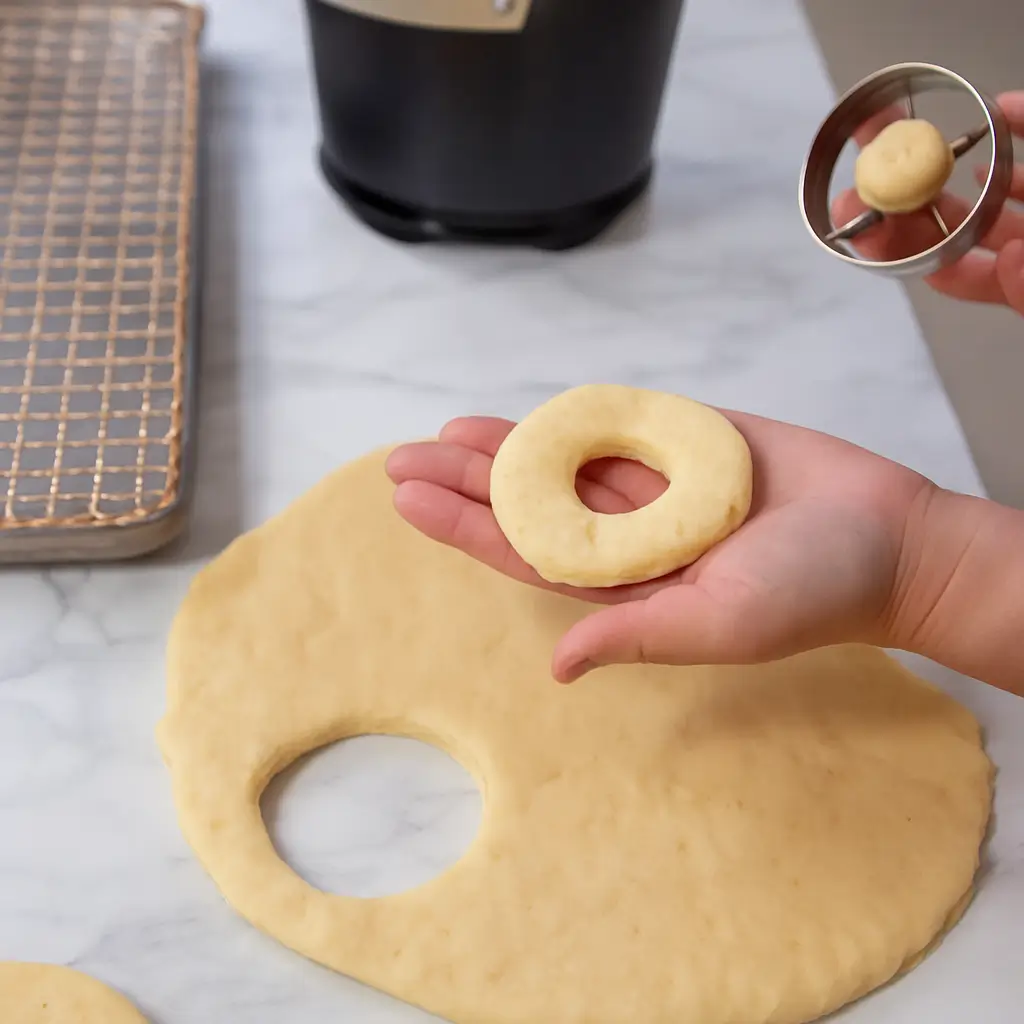
The result? A rich, fluffy base that’s ready for the dry ingredients.
Mixing, Folding, and Resting the Dough
Now comes the dry mix stage:
- With the mixer on low, gradually add your dry mix:
- 15 oz all-purpose flour
- 2 tsp baking powder
- 1 tsp baking soda
- ½ tsp salt
- ½ tsp nutmeg
- Mix until just combined. The dough will be soft and sticky—don’t overmix or you’ll lose that light, tender texture.
- Turn the dough out onto a lightly floured surface. Dust your hands and pat the dough gently into a 1-inch thick round.
- Fold the dough onto itself 3–4 times. This gives the donuts a bit of extra lift and structure.
- Flatten to ½ inch thickness. Cover with a towel and let the dough rest for 5–10 minutes. This makes it easier to cut and keeps it from shrinking when fried.
- Cut out your donuts using a donut cutter or two round cutters (one large and one small). Gather and reuse scraps as needed, but don’t overwork them.
- While dough rests again, heat oil to 360°F–375°F. Use a thermometer for accuracy.
Learn more about Mediterranean Quinoa Power Bowl as a wholesome side to pair with your donut brunch.
Frying Techniques for Cake Donuts
Ideal Temperature Range for Frying Donuts
Now that your dough is prepped and shaped, it’s time for the crucial step: frying. A proper fry can make or break your cake donut recipe, so follow these tips to get golden, crisp, tender donuts every time.
- Heat your oil to 360°F–375°F (182°C–190°C). Any hotter and the donuts will brown too fast without cooking inside; any cooler and they’ll soak up oil and turn greasy.
- Use a deep pot filled with 3–4 inches of oil or lard (about 4 cups). Avoid overcrowding—this drops the temperature quickly.
- Use a slotted spoon or spider skimmer to lower donuts gently into the oil.
- Fry each donut for about 2 minutes on the first side, then flip and fry for 1 more minute. For donut holes, fry 1 minute total, stirring to brown all sides.

How To Make Easy cake donut recipe At home
- Total Time: 30 minutes
- Yield: 12 donuts 1x
Description
classic cake donut recipe that yields rich, cakey donuts with a crisp golden crust and moist center. Perfectly fried and finished with your choice of glaze or cinnamon sugar.
Ingredients
For the Donuts
- 4 oz unsalted butter, softened
- 5 oz granulated sugar
- 2 large eggs, room temperature
- 6 oz buttermilk, room temperature
- 2 tsp vanilla extract
- 15 oz all-purpose flour
- 2 tsp baking powder
- 1 tsp baking soda
- ½ tsp nutmeg
- ½ tsp salt
- 32 oz lard or oil for frying (approx. 4 cups)
Classic Glaze
- 5 oz powdered sugar
- 2 tbsp milk or water
Chocolate Glaze
- 4 oz chocolate chips
- 2 tbsp butter
- 1 tbsp corn syrup or honey
- 2 tbsp heavy cream
Cinnamon Sugar
- 1 cup granulated sugar
- 2 tbsp ground cinnamon
Instructions
Make the Donut Dough
1. In a stand mixer, cream butter and sugar until light and fluffy.
2. Add eggs one at a time; mix until smooth.
3. Mix in buttermilk and vanilla.
4. Combine flour, baking powder, baking soda, nutmeg, and salt; add to the bowl and mix just until combined.
5. Turn dough onto a floured surface, press to 1″ thick, fold 3–4 times, then roll to ½” thick. Rest 10 minutes.
Cut and Fry
6. Cut out donuts with a donut cutter.
7. Heat oil to 360°F–375°F in a heavy pot or fryer.
8. Gently lower donuts into oil. Fry 2 minutes per side (or 1 min for holes).
9. Drain on a wire rack over a sheet pan.
Glaze or Coat
10. While warm, dip donuts in glaze or toss in cinnamon sugar.
11. Let set on rack before serving.
Notes
– Don’t overmix the dough to avoid tough donuts.
– Use a thermometer to keep frying oil at the right temperature.
– Let dough rest before frying to prevent shrinkage.
– Store in a paper bag at room temp for 1–2 days (best fresh!).
– Do not refrigerate—they’ll dry out.
Notes
- Don’t overmix the dough — mix just until ingredients are combined. Overmixing leads to tough, dense donuts.
- Use a thermometer to maintain the frying temperature between 360°F and 375°F. This prevents soggy or burnt donuts.
- Let the dough rest for 5–10 minutes before cutting and frying. This reduces shrinkage and improves texture.
- Cut donuts gently and avoid re-rolling the scraps too many times — this prevents toughness.
- Drain donuts on a wire rack instead of paper towels to keep the bottom crisp and avoid excess oil absorption.
- Store at room temperature in a paper bag or loosely covered container for up to 2 days.
- Do not refrigerate — this dries out the donuts.
- Freeze unglazed donuts for longer storage (up to 2 months). Thaw at room temp and reheat in the oven before glazing.
- Prep Time: 10 minutes
- Cook Time: 20 minutes
- Category: Breakfast, Dessert
- Method: Frying
- Cuisine: American
You’ll know they’re done when:
- They’re golden brown on both sides
- They float to the top quickly and puff up
- The crust feels slightly firm but not hard
Pro Tip: Always test the temperature between batches. Oil temp drops after each fry, and overheating can ruin your donuts.
Common Frying Mistakes and How to Avoid Them
Many homemade donuts go wrong not because of the recipe, but because of a few avoidable frying mistakes:
| Mistake | Result | Fix |
|---|---|---|
| Wrong pot size | Overflow, uneven fry | Use a deep, wide pot or electric fryer |
| Skipping thermometer | Undercooked or burnt | Always monitor temperature |
| Overcrowding | Oil temp drops, soggy donuts | Fry 2–3 donuts at a time |
| Draining on paper towels | Soggy bottoms | Drain on a wire rack over a sheet pan |
| Reusing old oil | Off taste, dark donuts | Use fresh oil or strain carefully between uses |
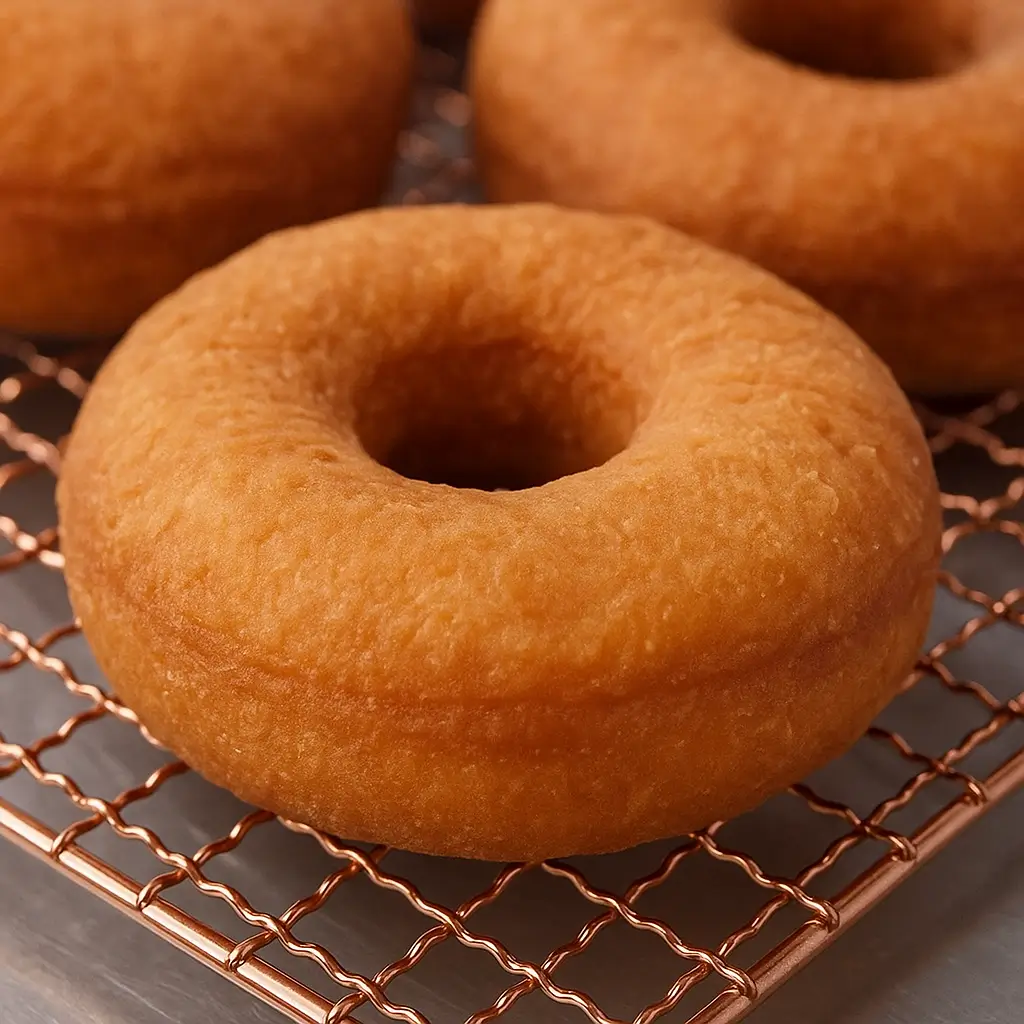
Check out How to Make Slutty Brownies Step-by-Step at Home for another deep-fry (or indulgent bake) project that requires similar kitchen finesse.
Flavor Variations & Glazing Options
Classic, Chocolate, and Cinnamon Sugar Glazes
You’ve mastered the fry—now let’s talk toppings, because no cake donut recipe is complete without a crave-worthy glaze or sugary coating. Here are three tried-and-true favorites:
1. Classic Donut Glaze
Simple. Sweet. Perfect.
Ingredients:
- 5 oz powdered sugar
- 2 tbsp milk or water
Instructions:
- Sift powdered sugar into a bowl to eliminate lumps.
- Add milk or water gradually while whisking until smooth.
- Dip warm donuts halfway into the glaze and let the excess drip off on a wire rack.
2. Chocolate Glaze
Rich and indulgent.
Ingredients:
- 4 oz chocolate chips
- 2 tbsp butter
- 1 tbsp corn syrup (or honey)
- 2 tbsp heavy cream
Instructions:
- In a microwave-safe bowl, combine all ingredients.
- Heat for 30 seconds, stir, then microwave again for 15 seconds if needed.
- Dip donuts face-down, twist slightly, and place on a rack to set.
3. Cinnamon Sugar Coating
Cozy and nostalgic.
Ingredients:
- 1 cup granulated sugar
- 2 tbsp cinnamon
Instructions:
- Mix cinnamon and sugar in a bowl.
- While donuts are still warm, toss them in the mixture until fully coated.
This is a great no-fuss option—especially when you’re making a big batch or want to skip messy glazing.
Check out How to Make Pancakes with Bisquick Better for another classic breakfast makeover with endless topping ideas.
Adding a Twist: Fun Toppings for Cake Donuts
Feeling adventurous? Here are some creative ways to elevate your donuts:
| Topping | How to Use | Flavor Boost |
|---|---|---|
| Crushed Oreos | Press onto freshly glazed donuts | Crunchy & chocolatey |
| Chopped Nuts | Sprinkle on top of chocolate glaze | Adds texture & richness |
| Sprinkles | Classic for kids and parties | Colorful & festive |
| Zested Citrus | Add lemon or orange zest to glaze | Brightens up sweetness |
| Maple Glaze + Bacon Bits | A sweet-savory favorite | Breakfast in a bite |
Don’t be afraid to experiment—your donuts, your rules!
Storing and Serving Your Cake Donuts
Best Ways to Keep Donuts Fresh Longer
You’ve put in the work—now let’s make sure those golden, fluffy beauties stay that way. Proper storage ensures your cake donuts maintain their flavor and texture for as long as possible.
- Store at Room Temperature: Keep donuts in a paper bag or a loosely covered container for up to 2 days. This prevents condensation, which can make them soggy.
- Avoid Refrigeration: The fridge dries out donuts quickly and ruins the texture. Only refrigerate if filled with cream or dairy-based toppings.
- To Reheat: Warm donuts in the microwave for 10–15 seconds or in a 300°F oven for 4–5 minutes to restore softness and aroma.
For longer storage:
- Freeze Un-glazed Donuts: Once cooled, wrap each donut individually in plastic wrap, then store in a zip-top freezer bag. They’ll keep for up to 2 months.
- Reheat from Frozen: Thaw at room temp and warm in the oven for 5–6 minutes at 325°F.
Don’t miss our Easy Sloppy Joe Recipe with Ketchup if you want to balance your sweet with something savory and family-friendly.
Serving Ideas and Pairings
Donuts can shine on their own, but pair them thoughtfully and you’ve got a full breakfast (or brunch) spread worth showing off.
| Pairing Idea | Why It Works |
|---|---|
| Hot Coffee or Cold Brew | The bitterness balances the sweetness |
| Vanilla or Cinnamon Latte | Enhances the glaze’s spice notes |
| Fresh Berries & Yogurt | Adds freshness and cuts the richness |
| Egg Casserole or Frittata | Makes a hearty, sweet-savory brunch |
| Whipped Cream or Ice Cream | For dessert, not breakfast—but we won’t judge! |
Discover great ideas like Sun-Dried Tomato and Feta Stuffed French Toast if you’re planning a deluxe brunch lineup.
Troubleshooting Common Cake Donut Issues
Even the best bakers hit a snag. If your cake donut recipe didn’t come out picture-perfect, don’t toss the batch just yet. Let’s fix what went wrong and ensure next time’s flawless.
Why Are My Donuts Greasy, Dense, or Dry?
If your donuts didn’t hit that sweet spot between crispy and tender, here’s why—and how to fix it:
| Problem | Cause | Fix |
|---|---|---|
| Greasy Donuts | Oil was too cold | Keep oil between 360°F–375°F. Use a thermometer every batch. |
| Dry Donuts | Overmixed or over-fried | Mix just until combined; fry no more than 3 minutes total. |
| Dense Texture | Overworked dough or too much flour | Handle dough lightly, don’t over-knead, and measure flour accurately. |
| Flat Donuts | Dough not rested or oil too hot | Let dough sit 5–10 min before frying and monitor heat closely. |
Fixing Texture, Taste, and Appearance
Let’s say your donuts cooked fine but don’t look bakery-fresh—no problem:
- Too Pale? Your oil might be underheated. Wait for it to return to 375°F before the next batch.
- Over-browned? Lower your heat slightly or shorten fry time.
- Cracked Tops? That’s usually from over-flouring or an under-mixed dough—add less flour on your board and knead minimally.
Check out How to Make Pancakes with Bisquick Better for tips that also apply to flour-based breakfast treats.
Healthier Alternatives – Can You Bake Cake Donuts?
Trying to enjoy donuts without the deep-fry guilt? You’re not alone. Let’s explore whether the beloved cake donut recipe can be transformed into a baked version—without sacrificing too much of that signature taste.
Baking vs. Frying: Pros and Cons
You can bake cake donuts, but they won’t be exactly the same. Here’s a quick comparison:
| Method | Pros | Cons |
|---|---|---|
| Fried | Crisp outer shell, tender interior, authentic flavor | Higher fat content, more cleanup |
| Baked | Healthier, simpler cleanup, less mess | Slightly drier texture, no crispy crust |
To bake instead of fry:
- Preheat oven to 375°F
- Pipe the dough into greased donut pans
- Bake for 12–15 minutes or until golden brown
- Cool and glaze as usual
Baking yields a cake-like donut texture—think muffin in a ring shape—but still totally delicious.
Making a Baked Cake Donut Without Losing Flavor
The secret to flavorful baked donuts is moisture and balance. Follow these tips:
- Add a tablespoon of oil or Greek yogurt to the dough for added moisture.
- Glaze immediately after baking while they’re still warm.
- Use bold toppings (like cinnamon sugar or chocolate glaze) to amp up flavor and mouthfeel.
While you may not get the same crisp edge, baked donuts can be a satisfying, everyday version of their deep-fried cousin.
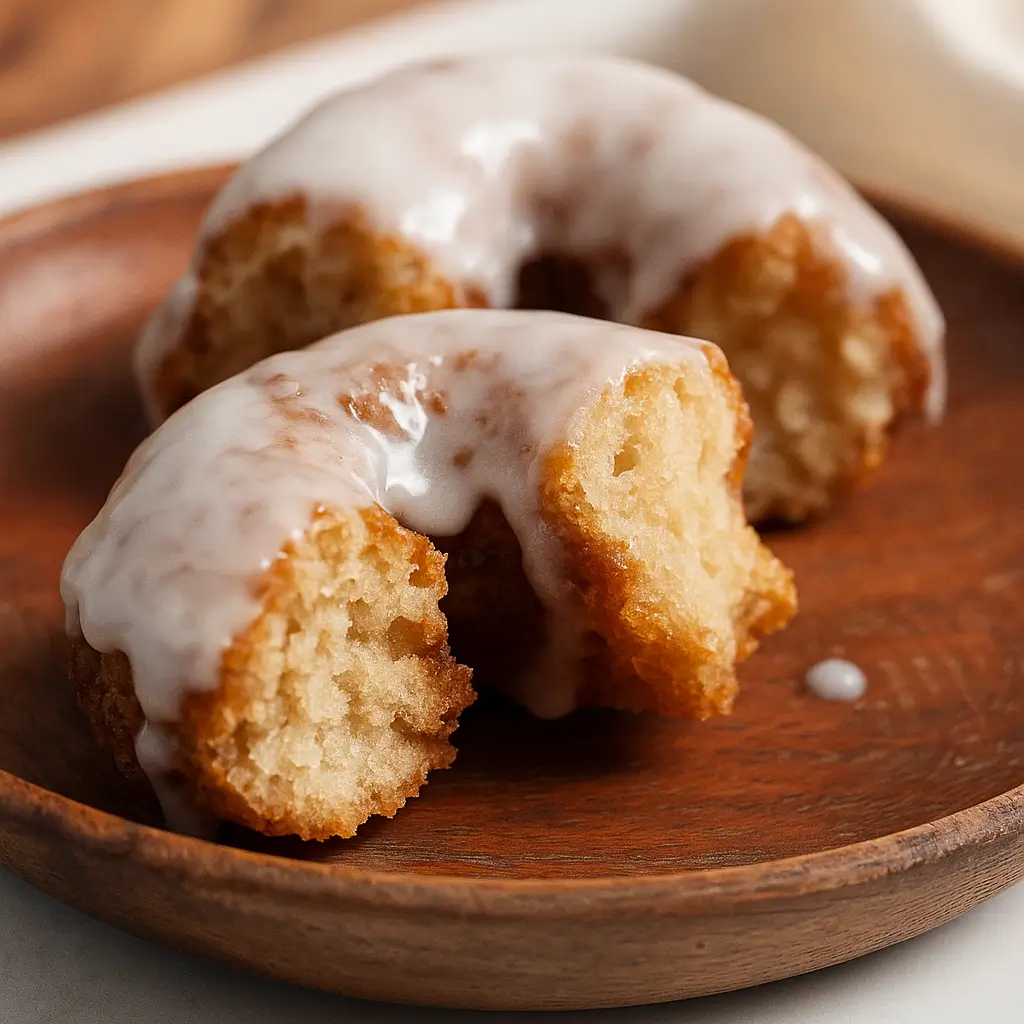
Don’t miss our Vegan Christmas Cookies Everyone Will Love for more feel-good baked dessert ideas.
FAQ: Cake Donut Recipe – Answers to Common Questions
How are cake doughnuts made?
Cake doughnuts are made using a batter or dough that’s leavened with baking powder or baking soda instead of yeast. The dough is mixed, shaped, and either fried or baked. Classic cake donuts are deep-fried at 360°F–375°F to create a crispy outer crust and tender, moist center. After frying, they’re topped with glazes or coatings like powdered sugar or cinnamon sugar.
What is the difference between a cake donut and a regular donut?
The main difference lies in the leavening agent. Cake donuts use baking powder or soda, giving them a denser, cakier texture. Regular donuts (yeast donuts) use yeast, resulting in a lighter, airier bite. Cake donuts are also easier and faster to make, as they don’t require rising time.
Is a cake donut fried or baked?
Traditionally, cake donuts are fried, which gives them their signature crispy outside and tender inside. However, they can also be baked for a healthier option. Baked cake donuts are softer and more muffin-like but still tasty, especially with a rich glaze.
What is the secret ingredient in doughnuts?
The subtle addition of nutmeg is often the secret flavor that makes classic cake donuts taste like the real deal. It’s warm, aromatic, and enhances the rich sweetness of the dough. Don’t skip it—it’s the difference between “good” and “wow.”
Why are cake donuts so good?
Cake donuts are loved for their texture—moist, dense, and slightly crumbly with a crisp edge when fried. Add to that the sweet glazes, warm spices like nutmeg, and quick cooking time, and you’ve got a treat that satisfies without the fuss of yeast-based recipes.
Does donut fry or bake?
Both methods work, but traditionally, donuts are fried. Frying yields that golden crust and airy inside we associate with classic donuts. Baking is a cleaner, lower-fat alternative, great for home bakers who want convenience and a lighter treat.
- Visit the Facebook community’s / Pinterest
Kid-Friendly Cake Donut Recipe Ideas
Mini Cake Donuts: Perfect for Little Hands
Make smaller versions of your classic cake donut recipe using a mini donut pan or cutter. They’re perfect for lunchboxes, party favors, or just portion control. Add fun toppings like colored sprinkles or candy melts.
No-Mess Glaze Techniques for Kids
Let the kids dip or brush glaze onto their donuts using squeeze bottles or pastry brushes. This makes your cake donut recipe interactive and fun for family baking days.
Seasonal Variations of Your Cake Donut Recipe
Fall Favorites: Pumpkin Spice Cake Donuts
Add pumpkin puree and spices like cinnamon, clove, and allspice to your cake donut recipe base. It brings a cozy, seasonal twist that’s perfect for autumn gatherings.
Winter Wonders: Peppermint Chocolate Glaze
Mix crushed candy canes into a chocolate glaze for a festive donut topping. Pair it with your favorite cake donut recipe to make a December dessert everyone remembers.
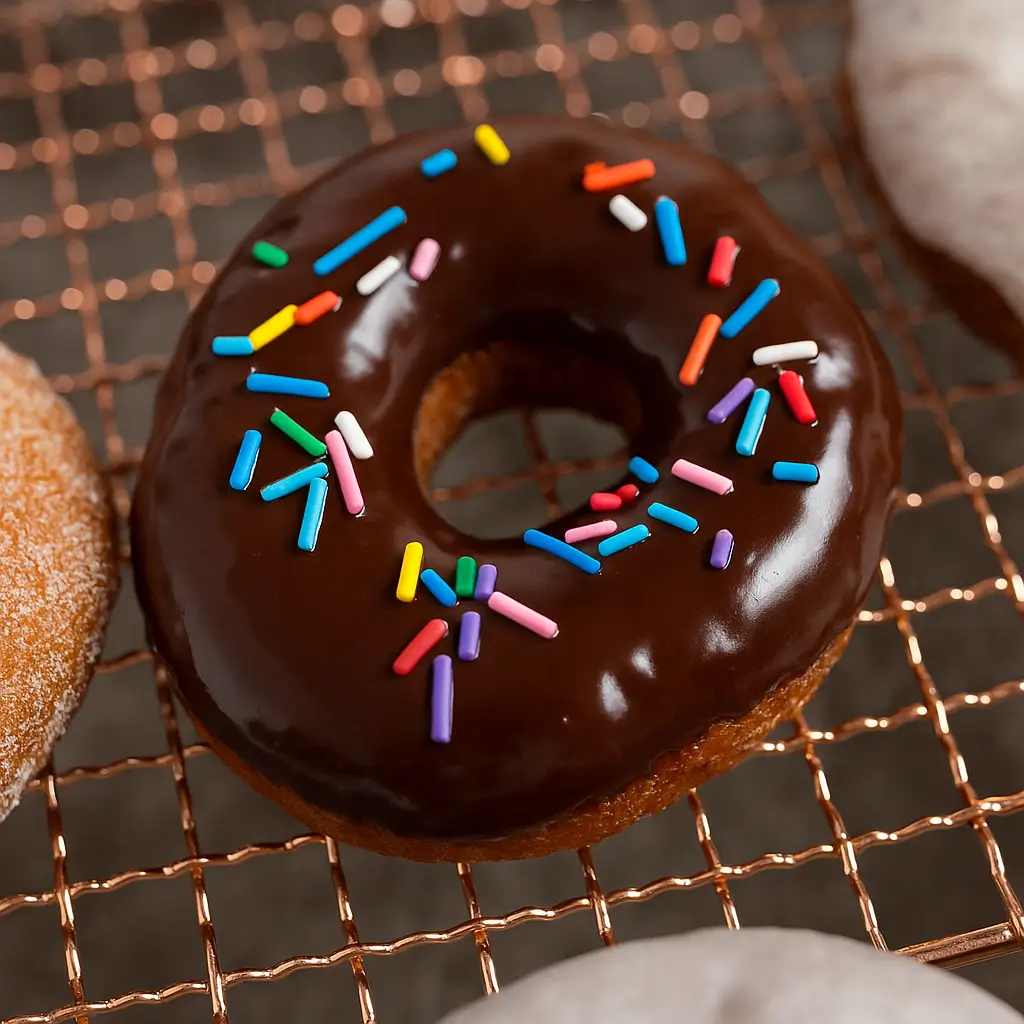
Using Your Cake Donut Recipe for Events & Gifting
Cake Donuts for Brunch Buffets or Weddings
Display mini donuts on tiered trays or create a donut wall for events. Your classic cake donut recipe becomes an eye-catching (and edible) decoration.
DIY Donut Kits as Homemade Gifts
Package pre-made donuts, mini glaze jars, and toppings in a box. Add a printed version of your cake donut recipe so recipients can recreate the magic at home.
